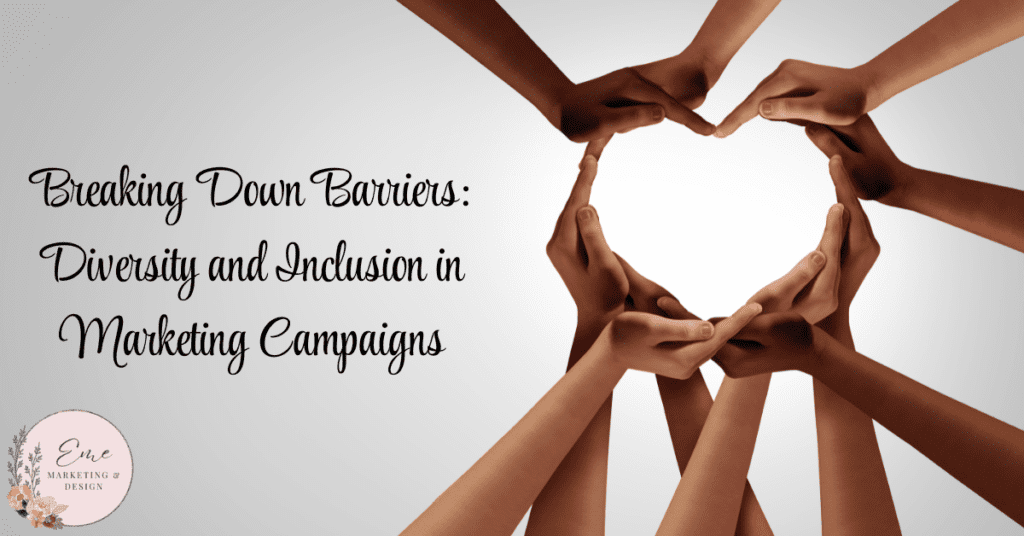
In today’s global marketplace, diversity and inclusion are more than just buzzwords; they are essential elements of successful marketing strategies. As societies become increasingly diverse, consumers expect brands to reflect this diversity in their campaigns. Companies that embrace diversity and inclusion (D&I) foster a more inclusive culture, drive innovation and enhance brand loyalty. This blog will explore the importance of D&I in marketing campaigns, the challenges brands face, and successful examples of inclusive marketing.
The Importance of Diversity and Inclusion in Marketing
Reflecting Society’s Diversity
Consumers come from various backgrounds, ethnicities, genders, sexual orientations and abilities. Marketing campaigns that reflect this diversity resonate more deeply with audiences. When people see themselves represented in advertising, it fosters a sense of belonging and connection with the brand.
Enhancing Brand Reputation
Brands that prioritize D&I demonstrate a commitment to social responsibility. This can significantly enhance their reputation, as modern consumers are more likely to support companies that align with their values. A study by Deloitte found that 57% of consumers are more loyal to brands that commit to addressing social inequities.
Driving Innovation and Creativity
Diverse teams bring many perspectives and ideas, which can lead to more innovative and creative marketing strategies. By embracing a variety of viewpoints, brands can develop campaigns that appeal to a broader audience and stand out in a crowded marketplace.
Expanding Market Reach
Inclusive marketing can help brands tap into new markets and demographics. By acknowledging and celebrating diversity, companies can attract customers from different cultural backgrounds who may have previously felt overlooked.
Challenges in Implementing D&I in Marketing
Tokenism
One of the significant challenges in implementing D&I is avoiding tokenism – the practice of making a perfunctory or symbolic effort to be inclusive. Tokenism can be damaging as it often comes across as inauthentic and can alienate the very groups a brand is trying to engage. Genuine representation requires a more profound commitment to understanding and valuing the experiences of diverse communities.
Stereotyping
Another challenge is avoiding stereotypes. Stereotypical portrayals can reinforce negative perceptions and do more harm than good. Brands must portray individuals in a way that reflects their real experiences and avoids reducing them to clichés.
Lack of Diverse Voices in Decision-Making
Having diverse voices at the decision-making table is crucial to creating truly inclusive campaigns. Without diverse perspectives in leadership roles, marketing efforts can miss the mark. Brands need to ensure that their teams include people from various backgrounds who can contribute to creating authentic and relatable content.
Navigating Cultural Sensitivities
Marketing to a global audience means navigating different cultural sensitivities. What works in one market might not resonate in another and could even be offensive. Brands must understand their target audience’s cultural nuances to create effective and respectful campaigns.
Successful Examples of Inclusive Marketing
Dove’s “Real Beauty” Campaign
Dove’s “Real Beauty” campaign is often cited as a benchmark for inclusive marketing. Launched in 2004, the campaign featured women of various ages, sizes, and ethnicities, challenging traditional beauty standards. By showcasing real women and their stories, Dove resonated with a broad audience and sparked a global conversation about beauty and self-esteem.
Nike’s “Dream Crazier” Campaign
Nike’s “Dream Crazier” campaign, narrated by tennis star Serena Williams, celebrated female athletes who broke barriers and defied stereotypes. The campaign highlighted women from diverse backgrounds and sports, reinforcing Nike’s commitment to inclusivity and gender equality. It received widespread acclaim for its empowering message and authentic representation of women in sports.
Coca-Cola’s “It’s Beautiful” Campaign
Coca-Cola’s “It’s Beautiful” campaign debuted during the Super Bowl in 2014 and featured a multilingual rendition of “America the Beautiful.” The ad showcased the diversity of the American population, with people from various ethnic backgrounds singing in different languages. Despite some backlash, the campaign was praised for celebrating multiculturalism and inclusivity.
Microsoft’s “We All Win” Campaign
Microsoft’s “We All Win” campaign, launched during the 2019 Super Bowl, highlighted the Xbox Adaptive Controller, designed for gamers with disabilities. The ad featured children with disabilities playing video games using the controller, emphasizing inclusivity and the idea that everyone can enjoy gaming. The campaign was lauded for its positive representation of people with disabilities and its focus on accessibility.
Strategies for Creating Inclusive Marketing Campaigns
Conduct Thorough Research
To create inclusive campaigns, brands must conduct thorough research to understand the needs and preferences of diverse audiences. This includes engaging with diverse communities, conducting focus groups, and analyzing demographic data. Research helps brands avoid assumptions and create content that resonates authentically with their target audience.
Involve Diverse Teams
Diversity in marketing teams is crucial for generating inclusive ideas. Brands should strive to include individuals from various backgrounds in their creative and decision-making processes. This not only helps in developing more relatable campaigns but also fosters an inclusive workplace culture.
Prioritize Authentic Storytelling
Authenticity is vital to successful inclusive marketing. Brands should prioritize authentic storytelling that reflects the real experiences of diverse individuals. This involves moving beyond superficial representation and sharing meaningful narratives that resonate with audiences more deeply.
Partner with Diverse Influencers
Collaborating with influencers from diverse backgrounds can amplify a brand’s inclusive message. Influencers have the power to reach specific communities and can lend credibility to a brand’s efforts. It’s important to choose influencers whose values align with those of the brand and who have genuine connections with their followers.
Monitor and Adjust
Inclusivity in marketing is an ongoing process that requires continuous monitoring and adjustment. Brands should regularly review their campaigns to ensure they remain relevant and respectful. Gathering feedback from diverse audiences can provide valuable insights and help brands refine their strategies.
Final Thoughts on Diversity and Inclusion in Marketing Campaigns
Diversity and inclusion in marketing campaigns are not just ethical imperatives but also business imperatives. Brands that embrace D&I are better positioned to connect with a broad audience, foster loyalty, and drive innovation. However, creating truly inclusive campaigns requires a genuine commitment to understanding and valuing diversity. By conducting thorough research, involving diverse teams, prioritizing authentic storytelling, partnering with diverse influencers, and continuously monitoring and adjusting their strategies, brands can break down barriers and create impactful, inclusive marketing campaigns. As society continues to evolve, the brands that will thrive reflect and celebrate the rich tapestry of human diversity.
Need help with your marketing campaigns?
We have over two decades of experience to assist your marketing goals and growth.




